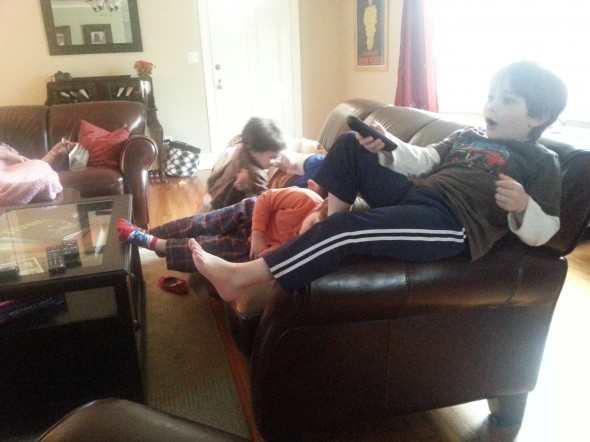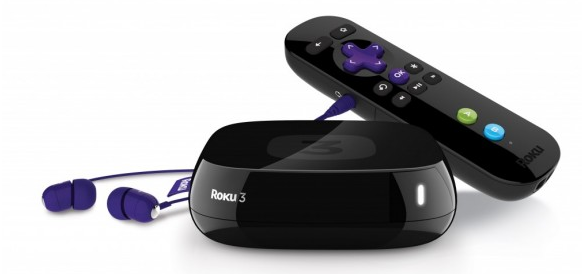It’s been a few months since the wife and I cut the cable cord. We’ve gotten into a new groove with media consumption and I thought I’d post an update for those who are considering making the move. Plus, everyone who comes over to our house wants to know all about the Roku, so I’ll get into that below.
Not much has really changed
The wife and I have always watched more films than TV shows (I’m not a big fan of lawyer/doctor/cop/reality shows). After cutting the cord, we still watch just about everything that we used to watch. In that sense, the conversion has been a success. But our set-up has some drawbacks.
The Roku 2 XS has been great little device for connecting streaming apps to our HDTV. It works seamlessly with the biggest and best services. It even has Angry Birds, which is controlled with the bluetooth remote. That came in very handy when the nephews were getting stir crazy at my place a few weeks ago.

We also have an HTPC pluggined into the TV to get around the limitations of the Roku, but we don’t use it very much. Occasionally, we’ll watch a show on a TV channel website or on YouTube or something like that, but almost everything else is accessed via the Roku or the BluRay player.
The Roku can be a little buggy sometimes. About once per month, it will freeze and I have to reset it. There’s a handy reset button built into the remote (in the covered battery tray), so it’s not a big deal, but it’s still disruptive when it happens. A new user interface is supposedly coming to Roku that will allow for cross-platform searching—a feature that is badly needed. But, most of the time, we just turn on the TV, open the streaming service that has our watchlist/queue of movies and shows, and we pick something to watch. In most ways, it’s the same as it used to be when we browsed through our Charter DVR queue.
I might buy the new Roku 3 and move this Roku into another room (it can be hard-wired or wireless). The Roku 3 has a 3.5 mm jack built right into the remote control that lets you listen to your programming via earphones.

That would come in handy when the wife is running a loud sewing machine in the same room and I’m about to tear my hair out from the constant pausing and playing and pausing and playing and pausing and playing…
Another drawback is that we’re now using five remotes to access all of our media. We mostly just use the TV remote for volume and the Roku remote for watching our content, but there are times when we need to use the other remotes as well. That’s a real pain in the ass and the wife reminds me how confusing it is every time she gets frustrated. Remote control technology (along with batteries) is an area that has seen strikingly little innovation over the last twenty years. If you ask me, it’s time to abandon infrared and move everything to bluetooth. I should be able to program one minimalistic remote to control everything very simply, and that remote should not involve a flatscreen that I have to look at to use.
How we watch our content
Sadly, it’s going to take at least twenty years for media delivery to evolve away from the “TV channel” format (with pre-scheduled, serialized shows) to on-demand content that users can consume at their own pace. Despite a few very public (and very limited) forays into online access, networks and cable providers are being dragged kicking and screaming into the world of streaming. It upsets the existing power structure and they simply don’t know how to monetize it properly yet. It’s the same problem that publishers have been facing since the internet starting eroding their paid subscribers.
As a result, different media companies are joining forces to create competing streaming services that they hope will capture the small but growing market segment that eschews cable altogether, as well as to ward off the pirates who are already torrenting and streaming their content anyway. Some of these streaming services are better than others. We probably consume 95% of our media via the following five services.
- Netflix ($8 per month)
Netflix.com is probably the best known and most successful paid streaming service out there. Netflix offers a pretty extensive archive of old seasons of TV shows, documentary films, and it has a hit-or-miss selection of feature films. Their offering depends on their current contracts and can change with little warning. If you’re looking for current entertainment, Netflix is not your best bet. But at only $8 per month, it’s worth having just to push through commercial-free seasons of old shows that you never got around to watching live. Netflix is doing more than anyone else to create new content that’s only available online. They went so far as to develop a fourth season of the cult-classic show, Arrested Development, which will premier later this month. The best thing is that they release the entire season of proprietary shows at once. If you ask me, that’s the way it should be. Books aren’t released one chapter per week, are they? Plus, treating a show like a long movie allows producers/writers/directors to make a more complex and engaging storyline. - Hulu ($8 per month for full access)
NBC, Fox, ABC, TBS, and several other networks/studios are on board with the ad-supported Hulu.com. This is your best bet for watching current content outside of watching it live over the air. New programs usually appear on Hulu the day after they’ve aired. Hulu offers a tiered service that starts with a limited, free version and moves up to a paid subscription service. Even if you have the paid service, offerings are tiered even further. Some content can only be streamed on a laptop while others can be streamed on laptops and set-top boxes and tablets. Inexplicably, some content is restricted from mobile entirely. It really does’t make any sense, especially since the lines between laptop/tablet/smartphone have blurred lately. To make things even more confusing, some shows offer access to every archived episode and others only offer access to the last few episodes. And no matter whether you’re using a free subscription or a paid one, you’re still forced to endure commercials throughout the programs. These are the main drawbacks to Hulu, and they’re very annoying. - Amazon Prime Instant Video ($79 per year)
Amazon’s Prime Instant Video service is more like Netflix than Hulu. Most of what you can access is old and commercial-free, but Jeff Bezos is busy making deals to bring more and more content to the service’s virtual shelves. If you order several products via Amazon each year anyway, then it makes sense to be a Prime subscriber. You get free two-day shipping on most products, and you get access to Prime Instant Video for free. There’s a lot of overlap with the Netflix and Hulu archives, but there’s also a lot of content that’s only available on Amazon. - HBO (Free with cable subscription)
I’ve been telling people for years that if HBO and ESPN would just allow users to pay $5 per month to stream their content, then hordes of American families would drop cable TV overnight. HBO Go only allows people who currently subscribe to HBO via cable to access HBO programming online. This is the kind of contract entanglement that will take twenty years to undo. It’s said often that a lot of Netflix users borrow other people’s login credentials to watch an occasional show or film. No matter what percentage of Netflix users are “borrowers,” the rate must be much higher for users of HBO Go. The business model simply makes no sense. If you can get access to HBO Go, you’ll be treated to tons of feature films and HBO’s entire archive of shows, which is extensive. - Crackle (Free)
Columbia Pictures, TriStar Pictures, Screen Gems, and Sony are on board with Crackle.com, another ad-supported streaming service. This is more like Netflix than Hulu, although Crackle does offer some older shows and original series. Crackle features a pretty low-tech interface that crudely interrupts whatever you’re watching at pre-determined intervals to force you to watch an advertisement. It’s a free service, so there’s not much room to complain, but it’s distracting nonetheless.
Most of the other 5% of our media consumption comes from the occasional movie rental or purchased TV show that I’m too impatient to wait to see on Netflix or Amazon Prime Instant Video. We usually stream movie rentals via Amazon Instant Video (which is not free like Prime). It costs about $5 per movie. You have something like a month to get around to watching the movie, but once you actually start it, you only have access to it for two days. We usually rent a movie or two the week before a long trip and download it to the wife’s Kindle Fire HD. Then we watch it on the plane or in the hotel room. We always travel with an earphone splitter and a micro-HDMI cable that allows us to watch our Kindle content together directly on the tablet or on our hotel room TV.
When I buy a TV show, I usually pay around $3 per episode and I can access it the day after the show airs. It’s not the best solution (a fifteen-episode season is around $45!), but I usually let the episodes pile up so that I can plow through a bunch of them on a rainy Sunday. There are plenty of other streaming systems, such as Walmart’s VUDU, Apple’s iTunes and Google’s Play Store, but I stick with Amazon because of Prime. If you’re heavily into Apple or Google, then it makes sense to stay within your ecosystem for video purchases and paid rentals.
Successes and failures
We cut the cord primarily for cost savings. We used to pay Charter $186 per month plus $23 for Netflix. As of now, we pay $55 for a 30 Mbps internet connection. We pay $8 each for Netflix and Hulu, and another $15 for DVDs by mail from Netflix for newer releases (I don’t factor in the Amazon Prime membership because we make that up in shipping savings). That’s $31 on top of the internet fee, which comes to a combined $86 per month for all of our entertainment. So we have savings of $123 per month over our old cable bill, which amounts to almost $1500 per year. That adds up to a free vacation each year.
Sadly, much of the content we pay to stream is redundant across platforms. But because of a key show or two, we’re still bound to stick with all of these paid platforms for the time-being. What’s sadder still, we’re forced to watch commercials on Hulu, which is a step backwards from DVR playback. But since Hulu has pretty much replaced our DVR queue, the $8 we spend pales in comparison to a monthly cable bill—even a basic one.
Honestly, I think the entertainment set-up we have is good enough and it’ll only get better as more and more services adapt to capture the younger demographic that will never buy cable service at all. An unexpected benefit is that I’m more discerning with my TV time. Because I can’t passively stumble upon programs mid-way through, I don’t get sucked into watching the end of Rocky IV once per month like I used to. And I don’t waste my time watching infomercials about Time Life’s newest “Sounds of the 19[INSERT DECADE]s” CD collection or the latest iteration of the FlavorWave™ Oven.

We get a lot of HD network channels over the air, but I almost never watch live TV anymore. That’ll change when football season rolls around, but it just doesn’t occur to me to browse through channels at all. As a matter of fact, having digital cable reconditioned me to browse through menus rather than channels anyway, so moving to streaming wasn’t that big of a leap. When you consider that most of my cable TV experience consisted of watching DVR’d programs anyway, there’s really not much of a difference between then and now.
The future
There’s still ample room for someone to put everything in one box—a single, customizable, DVR-style interface for over-the-air channels, streaming apps, rental services, and owned media.
Microsoft has probably come the closest to a complete system with Media Center, but it’s a very long way from being easy for the average person to install and use. Word is out that Amazon is working on a set-top box, but they need to unclutter their existing user interface before they push into new territory. Rumors have also been swirling that Apple is working on a TV solution of some sort, but nothing reliable has emerged about it. Apple might be the only company with the clout necessary to set some fair and universal standards across the industry, much like they did with the introduction of iTunes for music a decade ago.
Several other start-ups are trying to take the baby steps necessary to get the ball rolling, but they’re being fought at every turn by the powers-that-be. CBS is even threatening to cease broadcasting on the public airwaves and move to cable to keep companies from being able to implement a single-box solution.
Like I said before, it will take twenty years before the existing power structure is sufficiently demolished. It’s been about twenty years since the Internet went mainstream, and book, magazine, and newspaper publishers are still struggling to adapt.






